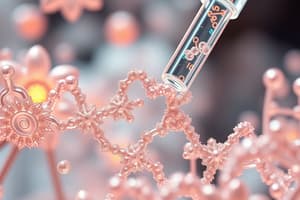Podcast
Questions and Answers
How does high GC content affect PCR reactions?
How does high GC content affect PCR reactions?
- Enhances DNA polymerase progression
- Reduces the need for optimizing conditions
- Increases the likelihood of secondary structures forming (correct)
- Promotes efficient primer binding
What is the impact of mispriming in PCR reactions?
What is the impact of mispriming in PCR reactions?
- Enhanced primer specificity
- Production of incorrect amplicon sizes (correct)
- Improved amplification yield
- Decreased likelihood of nonspecific products
How can mis-annealing of DNA affect PCR outcomes?
How can mis-annealing of DNA affect PCR outcomes?
- Promotes even product distribution
- Results in incomplete products (correct)
- Reduces nonspecific product formation
- Facilitates optimized elongation by DNA polymerase
What is a common consequence of secondary structures blocking DNA polymerase during PCR?
What is a common consequence of secondary structures blocking DNA polymerase during PCR?
How do incomplete products impact PCR results?
How do incomplete products impact PCR results?
What is a significant challenge posed by nonspecific products in PCR?
What is a significant challenge posed by nonspecific products in PCR?
Which factor contributes to the tendency of GC-rich templates to experience more severe consequences during mis-annealing in PCR?
Which factor contributes to the tendency of GC-rich templates to experience more severe consequences during mis-annealing in PCR?
What effect does mismatched base pairs between the template and primers have during the annealing phase of PCR?
What effect does mismatched base pairs between the template and primers have during the annealing phase of PCR?
How can researchers minimize the risk of mis-annealing events in PCR?
How can researchers minimize the risk of mis-annealing events in PCR?
What can impede the progression of DNA polymerase and result in truncated sequences in PCR amplification?
What can impede the progression of DNA polymerase and result in truncated sequences in PCR amplification?
What technique can be employed to minimize the occurrence of nonspecific products in PCR?
What technique can be employed to minimize the occurrence of nonspecific products in PCR?
How do incomplete PCR products differ from full-length amplicons?
How do incomplete PCR products differ from full-length amplicons?
Flashcards are hidden until you start studying
Study Notes
GC Content Affecting PCR Reaction
PCR, or Polymerase Chain Reaction, is a widely used technique for amplifying specific DNA sequences. However, the efficiency of this process can be affected by various factors, including the GC content of the target sequence. This article will explore how secondary structures blocking DNA polymerase, mispriming in PCR reactions, mis-annealing of DNA, incomplete products, and nonspecific products can impact the outcome of PCR amplification.
Secondary Structures Blocking DNA Polymerase
The presence of secondary structures such as hairpins, stem loops, or triple helices in double-stranded DNA can physically block the progression of DNA polymerase during the extension step of PCR. High GC content increases the likelihood of these structures forming, which may lead to reduced yields, uneven product distribution, or even complete cessation of amplification. To mitigate this issue, optimizing conditions like temperature gradients and ion concentration can help denature these secondary structures, enabling more efficient primer binding and subsequent elongation by the polymerase enzyme.
Mispriming in PCR
Mispriming occurs when primers bind to non-target sites within the template DNA molecule, leading to the production of incorrect amplicon sizes or unrelated sequences. While both high AT and high GC content regions have been implicated in mispriming, the latter tends to exhibit stronger effects due to its higher propensity to form stable secondary structures. For example, in a study comparing different GC contents with methylene blue, it was observed that a higher GC content led to a lower yield in PCR amplification due to increased mispriming events.
Mis-Annealing of DNA in PCR
During the annealing phase of PCR, mismatched base pairs between the template and the primers can cause mis-annealing, resulting in poor primer binding and decreased reaction efficiency. Again, while both GC and AT-rich regions are susceptible to mis-annealing, GC-rich templates tend to experience more severe consequences due to their tendency to favor secondary structure formation. By carefully selecting appropriate temperatures for annealing, researchers can minimize the risk of mis-annealing events, ensuring consistent and accurate PCR product generation.
Incomplete Products in PCR
Incomplete PCR products refer to fragments generated from the template DNA that do not correspond to the intended full-length amplicon. As noted earlier, GC-rich regions are more prone to secondary structure formation, which can impede the progression of DNA polymerase and result in truncated sequences. By adjusting the reaction parameters and using suitable nucleotide concentrations, scientists can improve the completion rate and reduce the occurrence of incomplete PCR products.
Nonspecific Products in PCR
Nonspecific PCR products arise from unintended amplification of genomic regions other than the desired target sequence. These unwanted products can complicate downstream applications, such as cloning, sequencing, and quantitative analysis. Similar to the issues discussed above, GC-rich regions can contribute to the formation of nonspecific products through the previously mentioned effects (secondary structures, mispriming, etc.). By employing advanced techniques like nested PCR, proofreading enzymes, and optimization of conditions, researchers can minimize the occurrence of nonspecific products and maintain the quality of their PCR outputs.
In conclusion, understanding the relationship between GC content and PCR performance is crucial for optimizing PCR protocols and achieving successful amplification outcomes. By considering aspects like secondary structures, mispriming, mis-annealing, incomplete products, and nonspecific products, researchers can develop strategies tailored to their specific targets, enhancing the overall reliability and accuracy of their PCR experiments.
Studying That Suits You
Use AI to generate personalized quizzes and flashcards to suit your learning preferences.




